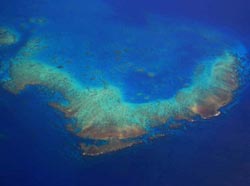Scientists develop CO2 sequestration technique

The Great Barrier Reef in Australia already has been affected by ocean warming and acidification.<br>
Lawrence Livermore scientists have discovered and demonstrated a new technique to remove and store atmospheric carbon dioxide while generating carbon-negative hydrogen and producing alkalinity, which can be used to offset ocean acidification.
The team demonstrated, at a laboratory scale, a system that uses the acidity normally produced in saline water electrolysis to accelerate silicate mineral dissolution while producing hydrogen fuel and other gases. The resulting electrolyte solution was shown to be significantly elevated in hydroxide concentration that in turn proved strongly absorptive and retentive of atmospheric CO2.
Further, the researchers suggest that the carbonate and bicarbonate produced in the process could be used to mitigate ongoing ocean acidification, similar to how an Alka Seltzer neutralizes excess acid in the stomach.
“We not only found a way to remove and store carbon dioxide from the atmosphere while producing valuable H2, we also suggest that we can help save marine ecosystems with this new technique,” said Greg Rau, an LLNL visiting scientist, senior scientist at UC Santa Cruz and lead author of a paper appearing this week (May 27) in the Proceedings of the National Academy of Sciences.
When carbon dioxide is released into the atmosphere, a significant fraction is passively taken up by the ocean forming carbonic acid that makes the ocean more acidic. This acidification has been shown to be harmful to many species of marine life, especially corals and shellfish. By the middle of this century, the globe will likely warm by at least 2 degrees Celsius and the oceans will experience a more than 60 percent increase in acidity relative to pre-industrial levels. The alkaline solution generated by the new process could be added to the ocean to help neutralize this acid and help offset its effects on marine biota. However, further research is needed, the authors said.
“When powered by renewable electricity and consuming globally abundant minerals and saline solutions, such systems at scale might provide a relatively efficient, high-capacity means to consume and store excess atmospheric CO2 as environmentally beneficial seawater bicarbonate or carbonate,” Rau said. “But the process also would produce a carbon-negative 'super green' fuel or chemical feedstock in the form of hydrogen.”
Most previously described chemical methods of atmospheric carbon dioxide capture and storage are costly, using thermal/mechanical procedures to concentrate molecular CO2 from the air while recycling reagents, a process that is cumbersome, inefficient and expensive.
“Our process avoids most of these issues by not requiring CO2 to be concentrated from air and stored in a molecular form, pointing the way to more cost-effective, environmentally beneficial, and safer air CO2 management with added benefits of renewable hydrogen fuel production and ocean alkalinity addition,” Rau said.
The team concluded that further research is needed to determine optimum designs and operating procedures, cost-effectiveness, and the net environmental impact/benefit of electrochemically mediated air CO2 capture and H2 production using base minerals.
Other Livermore researchers include Susan Carroll, William Bourcier, Michael Singleton, Megan Smith and Roger Aines.
More Information
“Marine species at risk unless drastic protection policies put in place,” LLNL news release, Aug. 20, 2012.
“Speeding up Mother Nature's very own CO2 mitigation process,” LLNL news release, Jan. 19, 2011.
“CO2 Mitigation via Capture and Chemical Conversion in Seawater,” Environmental Science & Technology.
Founded in 1952, Lawrence Livermore National Laboratory provides solutions to our nation's most important national security challenges through innovative science, engineering and technology. Lawrence Livermore National Laboratory is managed by Lawrence Livermore National Security, LLC for the U.S. Department of Energy's National Nuclear Security Administration.
Media Contact
All latest news from the category: Earth Sciences
Earth Sciences (also referred to as Geosciences), which deals with basic issues surrounding our planet, plays a vital role in the area of energy and raw materials supply.
Earth Sciences comprises subjects such as geology, geography, geological informatics, paleontology, mineralogy, petrography, crystallography, geophysics, geodesy, glaciology, cartography, photogrammetry, meteorology and seismology, early-warning systems, earthquake research and polar research.
Newest articles

High-energy-density aqueous battery based on halogen multi-electron transfer
Traditional non-aqueous lithium-ion batteries have a high energy density, but their safety is compromised due to the flammable organic electrolytes they utilize. Aqueous batteries use water as the solvent for…

First-ever combined heart pump and pig kidney transplant
…gives new hope to patient with terminal illness. Surgeons at NYU Langone Health performed the first-ever combined mechanical heart pump and gene-edited pig kidney transplant surgery in a 54-year-old woman…

Biophysics: Testing how well biomarkers work
LMU researchers have developed a method to determine how reliably target proteins can be labeled using super-resolution fluorescence microscopy. Modern microscopy techniques make it possible to examine the inner workings…





















